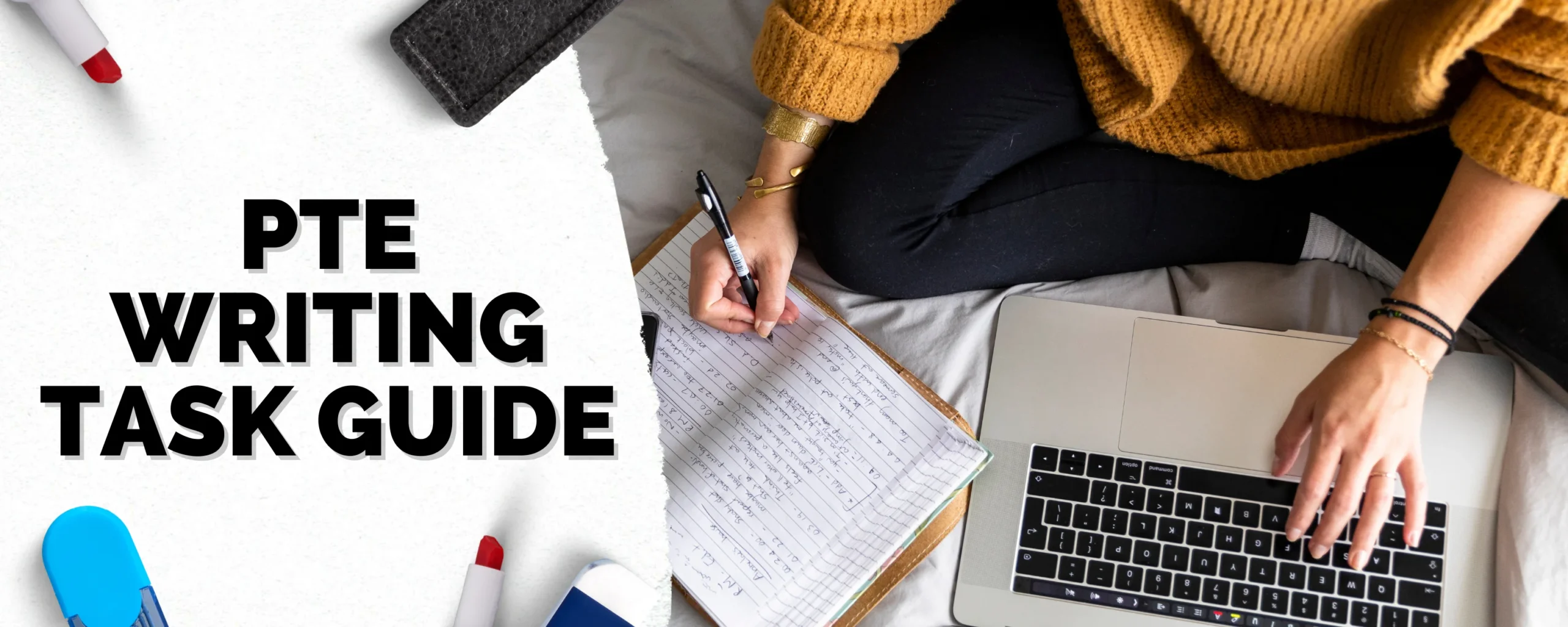The PTE Speaking section plays a crucial role in your overall PTE Academic score because it tests your ability to communicate effectively in English. But many students struggle with this section since it requires quick reflexes to process information and respond fluently within the given time limit.
Also, one might get overwhelmed with the unfamiliar question formats and some get nervous as they have to speak directly to the computer. But you can easily score 80+ in the Speaking & Writing module by selecting the right PTE preparation material. In this guide, we’ll break down every PTE Speaking question type, provide easy-to-use templates, and share expert tips you need to boost your performance and speak with clarity and confidence.
Overview of PTE Speaking Question Types
The PTE Speaking section is the first part of the test, lasting 24–37 minutes. This integrated task assess your listening, reading and speaking skills in an academic environment. You will speak into a microphone, and an AI system will assess your performance based on three key factors:
- Content – How well you convey information, opinions, and ideas.
- Oral Fluency – Your ability to speak smoothly without hesitation or unnatural pauses.
- Pronunciation – How easily understandable your speech is to native English speakers.
The PTE Speaking section consists of 5 different question types. Here’s a quick overview:
| Question Type | Number of Questions | Task Description | Skills Assessed | Scoring |
| Read aloud | 6-7 | You’ll be given a short text (60 words) to read aloud. | Reading and speaking | Pronunciation = 5 Fluency = 5 Content clarity = 5 |
| Repeat sentence | 10-12 | You’ll hear a sentence and must repeat it exactly. | Speaking | Listening & retention= 3 Pronunciation = 5 Speaking Fluency = 5 |
| Describe image | 3-4 | You’ll see an image (graph, chart, or picture) and need to describe it within a time limit. | Listening and speaking | Content = 5 Pronunciation = 5 Oral Fluency = 5 |
| Re-tell lecture | 1-2 | You’ll listen to a short lecture and summarize it in your own words. | Listening and speaking | Listening & retention = 5 Pronunciation = 5 Speaking Fluency = 5 |
| Answer short question | 5-6 | You’ll hear a question and need to give accurate answer in a single or few words. | Listening and speaking | Vocabulary = 2 |
| Time: 24-37 minutes | Score range = 60 | |||
Read Aloud
In this task, you will see a short text on the screen and must read it aloud with correct You have to read aloud a short text, with correct pronunciation and intonation in the allotted time.
Tips for Read Aloud
- Speak smoothly and clearly.
- Remember to emphasize key words and pause at appropriate places, such as commas and full stops, even if it’s just for a fraction of a second.
- Focus on clarity rather than speed. Take your time and don’t rush through the passage.
- If you realize you’ve mispronounced, don’t stop or repeat it! Keep speaking to ensure fluency.
- Practice rising intonation in the lists and falling intonation at the end of the sentence.
- Record and listen to your voice multiple times. Practice reading new passages with a timer and carefully track your speaking speed.
Repeat Sentence
You will hear a sentence recording and must repeat it exactly as spoken.
Tips for Repeat Sentence:
- Listen to the way the speaker groups the words into meaningful phrases. Mentally divide the sentence for easy recall.
- Once the audio clip starts you can close your eyes to memorize the sentence better.
- Avoid false starting a sentence, and try to repeat everything in the same sequence as you heard in the audio.
- If you can’t manage to remember the whole sentence, do not pause or hesitate. Just least focus on the keywords and repeat those.
- Use shadowing techniques.
- You might hear different accents, don’t copy that, you should stay as natural as possible.
Describe Image
You have 40 seconds to describe the information in a graph, chart, map, picture or table.
Tips for describe image:
- Focus on main trends instead of small details. Though a good response includes both the main points and supporting details.
- Make good use of preparation time and speak fluently and naturally.
- If possible, students should prepare their own template for Describe Image in PTE.
- Use of words:
- Start your speech with words like illustrate, depict, elucidate, etc.
- Use transition words like “in contrast,” “similarly,” etc.
- Prepositions of position while describing like on the left/right side, next to, above, at the top, below/bottom, foreground, background, and others.
- Do not speak too fast or too slow, also do not mumble or self-correct yourself.
- Avoid fillers, fumbles and long pauses.
- Strengthen your Speaking skills through practice strategies and expert techniques.
Template for Describe Image:
The given [XYZ] gives information regarding [Image Heading] It is evident from the [XYZ] that the highest/maximum element from the picture is ……. for ……….., whereas the lowest/minimum element from the picture is ………..for………. Moreover, it shows up-ward/downward trend. Overall, it is an informative image and can be used for future reference.
Re-tell Lecture
You will hear a lecture and must summarize it in your own words.
Tips for Re-tell Lecture:
- Develop your own technique for quick and fast note-making. Decide your own abbreviations and symbols and practice using them so that you are in a habit of using them.
- Listen and take clear note of words, each word in a new line so that it becomes easy for you to speak in an organized way.
- Focus on main ideas to grasp the lecture’s context rather than exact words.
- You do not need to recall full names. Instead, use titles such as Dr states or the professor says.
- Try to remember the best 3 to 5 sentences of the lecture.
Instead of complete full names, you can use titles, like – Dr Says or the professor mentions etc.
Template for Re-tell Lecture:
The lecture was about……
The speaker/lecturer was discussing……..
He/she mentioned……
He/she then talked about ……
After that, he/she discussed ……
Wrapping up the speech, the speaker sums up the lecture with……
Answer Short Questions
You will hear a question and must provide a one-word or short phrase answer.
Tips for Answer Short Questions:
- Build general knowledge.
- Add articles before some words. Though all will be marked correct. For ex: if the answer is circle, then circle, a circle, the circle all are correct.
- If you do not know how to answer, repeat the words in the question.
- Try to answer whatever comes to your mind but don’t leave it unattempted.
- Listen carefully to the whole question.
- Focus on the question word-who, what, how. This will help you guess the answer.
- Improve active listening skills by Practice with sample question banks.
Sample PTE speaking questions
1] What is the opposite of a plus sign?
Ans: minus sign
2] How many days are there in a leap year?
Ans: 366 days
3] How many years are there in a decade?
Ans: 10 years
4] In which direction does the sun come up?
Ans: East
5] What do we call the piece of paper that proves you have bought an item?
Ans: receipt
Templates for PTE Speaking
Cracking the PTE Speaking section becomes easier with sample templates along with example answers. Here are sample templates for different tasks:
Read Aloud
Example Sentence:
“The rapid advancements in artificial intelligence are reshaping industries, enhancing productivity, and transforming the way we live and work.”
Answer Delivery:
The rapid advancements in artificial intelligence / are reshaping industries, / enhancing productivity, / and transforming the way we live and work. (Pause slightly at slashes to maintain fluency.)
Describe Image
Sample Question:
‘International students enrolled in higher education in the top three countries, 2015–2019.’
Sample Answer:
Introduction:
First and foremost is the introduction. How can we paraphrase the title? Let’s look at a sample introduction.
This graph provides insights into the enrollment of international students in higher education for the years 2015 to 2019. The focus is on three countries – the US, the UK, and Australia.
Description:
Now, it is time to identify the three most important features. These could be the highest points, the lowest points, or another one.
Here is an example of the main features:
- The United States had the highest number of international student enrollments throughout the recorded years, fluctuating between 850,000 and nearly one million.
- In contrast, the number of international students studying in the UK, the second-most popular country, remained relatively steady, but much lower, at just over 400,000.
- Finally, Australia witnessed a continual rise in the population of overseas students, from around 300,000 to well over 400,000.
Conclusion: Once you have covered the three key points, it is time to conclude. You can summarise the data like this.
Re-tell Lecture
Sample Template:
- Introduction: “The lecture discussed [main topic].”
- Key Details: “It highlighted [point 1], [point 2], and [point 3].”
- Conclusion: “In summary, the speaker emphasized [final takeaway].”
Example Lecture Topic: “Effects of Global Warming on Marine Life”
Answer Delivery:
The lecture discussed the effects of global warming on marine life. It highlighted how rising temperatures impact coral reefs, ocean acidification, and fish migration patterns. In summary, the speaker emphasized the urgent need for climate action to protect marine ecosystems.
Answer Short Questions
Example Questions & Answers:
- What do we call a baby cat? → Kitten
- What instrument is used to measure temperature? → A Thermometer
- What is the opposite of ‘expand’? → Contract
Tips to Improve Your PTE Speaking Score
- Use templates to structure responses effectively.
- Complete the whole sentence in one go. Avoid taking unnecessary pauses
- Try to mimic native English speakers with different accents. Also focus on mimicking intonations as each word has ups and downs for each alphabet.
- The best way to practice for the speaking section of the PTE exam is to record and listen to your own voice so that you are able to self-correct your pronunciation and analyze the tone in a perfect manner.
- Always remember that you should never use fillers like hmm,aa, uuu while you speak. You will be scored low if you use fillers or even repeat a lot of words.
- Patience is the key to success. So, don’t panic because nervousness affects fluency. Instead stay calm and answer with confidence.
- Practice daily with structured mock tests. All you need to do is use effective strategies and put your efforts into choose the best PTE Academic preparation course.
Conclusion
PTE Speaking is now a piece of cake with the right mix of strategy, practice, and confidence. Using structured templates, proven techniques, and regular practice, you can significantly improve your fluency and pronunciation and overall score. Remember, consistency is key—practice daily, focus on clarity, and stay calm under pressure. Speak like a pro on exam day by expert-led PTE courses that give personalized coaching, proven strategies, and all the confidence you need to achieve your desired score!
Frequently Asked Questions
1. How Can I Improve My Speaking in PTE?
Ans: Improving your PTE Speaking requires a mix of fluency, pronunciation, and structured responses. Here are some key strategies:
- Practice Read Aloud – Focus on clear pronunciation and natural rhythm.
- Repeat Sentences Accurately – Improve your listening skills and mimic the exact tone and stress.
- Use Templates – Structured answers help you stay confident and organized.
- Speak Naturally – Avoid sounding robotic; keep your pace steady.
- Record & Evaluate – Listen to your responses and refine your mistakes.
- Consistent practice, time management, and confidence will boost your PTE Speaking score!
2. Which Template is Best for PTE?
Ans: The best PTE templates are those that provide a clear structure while allowing flexibility in answers. Here’s an example for the Describe Image task:
Template:
“The image illustrates [main topic]. On the left/right/top/bottom, we can see [key detail]. The most noticeable trend/pattern is [highlight key observation]. Overall, this image provides useful insights about [summary].”
Using templates ensures your answers are well-organized, helping you maintain fluency and coherence throughout the exam.
3. How to Get a Good Score in Speaking PTE?
Ans: Scoring well in PTE Speaking depends on:
- Fluency & Pronunciation – Speak smoothly without long pauses.
- Content Accuracy – Stay relevant and structured in your responses.
- Consistent Practice – Use PTE mock tests and feedback to refine your speech.
- Time Management – Keep an eye on the clock and avoid rushing or hesitating.
- Smart Strategies – Use templates, chunking techniques, and stress patterns effectively.





